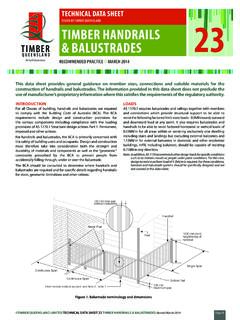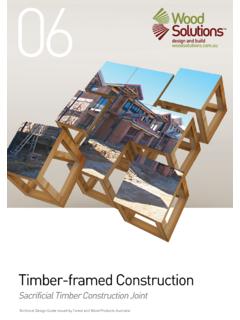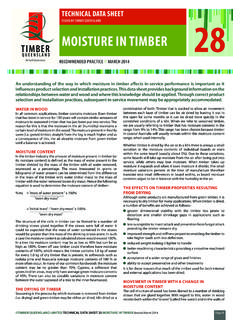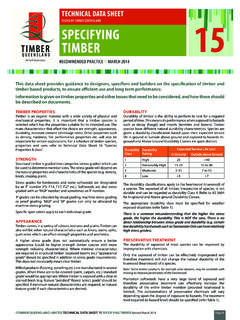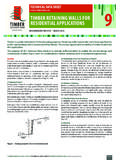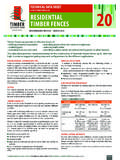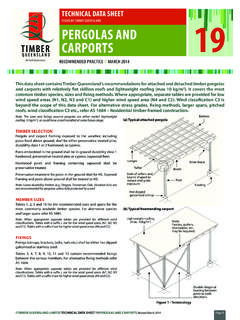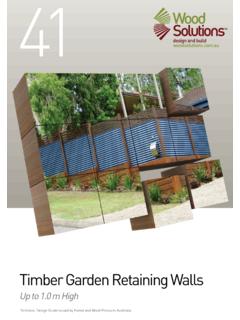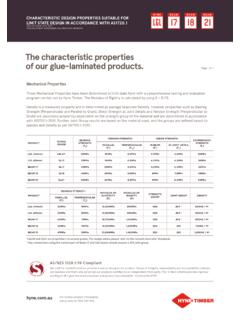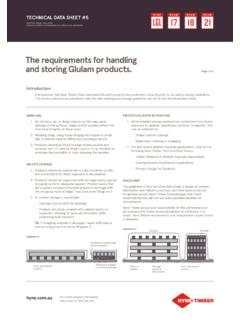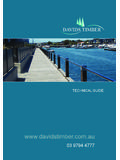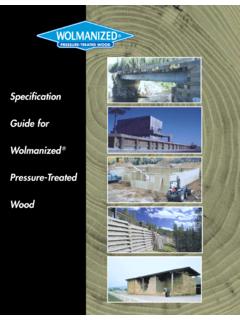Transcription of TECHNICAL DATA SHEET ISSUED BY TIMBER …
1 TIMBER QUEENSLAND LIMITED TECHNICAL DATA SHEET 7 TIMBER DECKS - COMMERCIAL, INDUSTRIAL & MARINE Revised August 2017 Page 1 TIMBER s natural appeal, strength and environmental credentials continue to make it the ideal choice for decking in commercial, industrial and marine structures, including: boardwalks jetties pontoons marinas bridges foot bridges loading docks vehicle parkingSCOPEThis data SHEET provides details for the design, specification and construction of TIMBER decks in fully exposed environments (including marine) in applications for light pedestrian traffic ( kN or kN point loads), heavy pedestrian traffic ( kN point loads) and light vehicular traffic (13 kN point loads) with uniformly distributed loads of up to 5 kPa.
2 Details for posts, other supporting/foundation structures and lateral stability etc. are not included and should be engineered for the specific site SELECTION AND DURABILITYThe traditional TIMBER used in Australia for heavy decking is inground durability class 1 or 2 hardwood. The reasons for this are ready availability, natural durability and proven performance with minimum treated seasoned softwoods are now widely used in applications such as foot bridges, boardwalks, 1 provides guidance on readily available species suitable for heavy decking. It is recommended that for hardwood a range of acceptable species be specified for a project rather than a single species which will limit detailed advice on TIMBER durability performance can be obtained from Construction TIMBER in Queensland (CTIQ), is the minimum treatment level for TIMBER used above ground, that is well ventilated & free draining.
3 For higher above ground hazard situations, H4 should be specified and is available in both unseasoned and seasoned TIMBER in a range of grades and GradeThe general grade descriptions provided by the relevant Australian Standards (AS 2082 - Visually Stress-Graded Hardwood, AS 2858 - Softwood - Visually Stress-Graded For Structural Purposes) satisfy the structural requirements for bearers, joists and greater serviceability, the following additional grade requirements should be specified for TIMBER decking boards: Open TIMBER features such as knot holes, loose or unsound knots, gum pockets, loose gum veins, shakes and termite galleries should not be permitted on the upper face on the or near square sections can be more economical than rectangular sections of equivalent structural capacity because they can be cut from smaller logs containing sound boxed heart.
4 Other advantages of square sections include longer length availability and greater lateral BOARD SIZES AND PROFILEST able 2 provides general guidance on sizes and stress grades which are usually available, however, individual suppliers should be contacted to determine availability of different size, species, grade and TEXTUREE xperience has shown that TIMBER with a sawn upper face provides greater long term weathering ability than a dressed surface. Decking therefore should be rough sawn all round or sized on two edges and one face (underside) AND CORNERSA 3 mm arris should be specified on the top corners. Some seasoned decking is available with rounded corners.
5 Such treatment of arrises or corners will reduce the incidence of splintering and improve the performance of 1 - SUITABLE SPECIESS peciesPost in GroundPosts, Framing and Decking Above GroundPRESERVATIVE TREATED PINE (Carribean, Hoop, Radiata, Slash) H5 Treatment(H6 Treatment in seawater contact) H3 Treatment (minimum)CYPRESS (See Note 1, 4)(See Note 4)BLACKBUTT(See Note 1)GUM Forest RedGUM GreyGUM Spotted(See Note 1)IRONBARK Red or GreyMAHOGANY Red(See Note 1)MAHOGANY WhiteMESSMATE GympieTALLOWWOODTURPENTINE(See Note 6)NOTES:1. These timbers are in-ground durability class 2 and may be used for in-ground applications only when they can be easily and economically replaced if degrade Hardwood decking boards containing sapwood must be preservative treated to H3 hazard level.
6 (H5 if less than 400 mm from the ground)RECOMMENDED PRACTICE // AUGUST 2017 TIMBER DECKSCOMMERCIAL, INDUSTRIAL & MARINETECHNICAL DATA SHEETISSUED BY TIMBER QUEENSLAND7 TIMBER QUEENSLAND LIMITED TECHNICAL DATA SHEET 7 TIMBER DECKS - COMMERCIAL, INDUSTRIAL & MARINE Revised August 2017 Page 23. Hardwood posts and framing containing more than 10% cross-section area of sapwood must be treated with preservative. (H5 level when in ground contact or less than 400 mm from the ground, H3 (min) elsewhere). Small amounts of sapwood (less than 10% of cross section) may remain untreated provided they do not occur at joints or fixing points (not exceeding 50% of face or edge).
7 4. Cypress sapwood should be limited to 10% of the cross section (not exceeding 50% of face or edge) and should not occur at joints or fixing Untreated softwood heartwood should be limited as for untreated hardwood sapwood (refer note 3).6. Suitable only for posts and seasoned 2 - DECKING BOARD SIZES AND STRESS GRADEST imberFinished or SizedStress Grades DimensionsHardwood - unseasoned35/45 x 70 *, 35/45 x 90 *35/45 x 120 *, 35/45 x 140 *F14, F17, F22 Hardwood - seasoned35/45 x 70, 35/45 x 9035/45 x 120, 35/45 x 140F17, F27 Softwood - seasoned35/45 x 70, 35/45 x 9035/45 x 120, 35/45 x 140F7, MGP 12 Cypress -unseasoned35/45 x 70 *, 35/45 x 90 *35/45 x 120 *, 35/45 x 140 *F5, F7* sized dimensionMOISTURE CONTENT AND SHRINKAGEE xternal decking timbers exposed to the weather will reach Equilibrium Moisture Content (EMC)
8 With their surroundings after a period of 9-18 months, depending upon prevailing weather, size and type of TIMBER coastal Australia, decks that are well ventilated should reach an EMC of approximately 16%. For decks close to and over water, EMC s will normally be a little higher (18-21%) and for dry inland areas considerably lower (10-12%).Depending on location and species, the amount of shrinkage occurring in unseasoned TIMBER will vary. Generally, about 6% shrinkage (6 mm per 100 mm) should be expected for unseasoned hardwood. An indication of shrinkage rates for individual species is given in TECHNICAL Data SHEET 16, Species Properties and should therefore be made for shrinkage in unseasoned bearers, joists and decking, and for the gaps that will develop between the decking minimum gap of 6 mm is recommended between decking boards to allow for good drainage and ventilation around decking boards should be laid tight together, with subsequent shrinkage creating the required gaps.
9 As an example, if unseasoned spotted gum decking (45 x 120 mm) was butted together on installation, the final gap between the boards would be approximately 6% of 120 = 7-8 decking should be installed with the required 6 mm minimum gap at the time of laying. Closing of these gaps may occur during prolonged wet periods. Larger gaps may be necessary for areas of higher EMC over StorageTimber delivered to site should be stored supported on level bearers not less than 150 mm clear of the ground. TIMBER should be left block stacked and banded until required. Both seasoned and unseasoned decking should be covered to protect it from the sun and and SealingTo reduce end splitting in unseasoned TIMBER , the end grain should be coated immediately after sawing with a suitable sealer such as Petroleum Jelly or Mobilcer-M Wax Emulsion.
10 In addition, all unseasoned sections 300 x 75 mm or greater should be end-plated with a multi-toothed plate connector covering at least 50% of the exposed end section. TIMBER should be specified and supplied to site with the end-sealing and plating already in fixings (nails, bolts, screws, plates, etc.) should be either stainless steel, monel metal, hot dipped galvanised or mechanically plated. Table 3 provides relevant fastener details for the fixing of the CCA, ACQ or copper azole treated TIMBER has been used and continual moisture is present, hot dipped galvanised bolts etc., should be coated with a heavy bodied grease, bitumuous epoxy paint or plastic sheath prior to 3 - DECK FIXINGDECKING BOARDSIZE (mm x mm) DeckJoist Width (mm)35 x 70 35 x 901 2100 x Flat Head or Dome Head Nail * (Pre-drilling may be required)5035 x 70 35 x 9035 x 12035 x 1401 22275 mm x Type 17 Batten Screw5045 x 7045 x 9045 x 120122125 x Dome Head Decking Spike(Pre-drilling Required)7545 x 7045 x 9045 x 12045 x 140122290/100 mm x Type 17 Batten Screw50 Pre-drillingBolt holes in unseasoned TIMBER should be drilled to a size equal to the bolt diameter + 10%.
